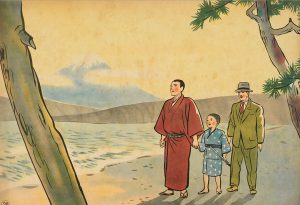
UBC Library has digitized an extremely rare collection of World War II-era propaganda plays from Japan, presented in a format known as kamishibai, or paper theatre, plays. Produced in the 1930s and 40s as wartime propaganda materials, the kamishibai plays in UBC Library’s newest digital collection are owned by Dr. Sharalyn Orbaugh, Professor of Modern Japanese Literature and Popular Culture and Head of the Department of Asian Studies at UBC. Working with librarians and student staff from Digital Services and the Asian Library, Dr. Orbaugh generously provided access to her extensive private collection, amassed over the last 25 years.
“Kamishibai plays were one of the most widely distributed and commonly experienced propaganda media in wartime Japan. Most of the thousands of plays that were produced were created by a small number of production companies that were closely monitored by the Japanese government,” says Dr. Orbaugh, whose collection consists of 120 plays, of which 52 plays were chosen to be digitized as part of this project. The plays are laid out on sets of cardboard cards with scripts on one side and illustrations on the other.
She collected her first kamishibai play when her partner, Dr. Joshua Mostow, Professor of Pre-modern Japanese Literature and Art in the Department of Asian Studies at UBC, found one at a flea market in Japan around 1995: “Being made of cardboard, kamishibai are fragile—they tear, they mold, they burn—and also people tended to throw them away after the war because the stories were considered dangerous to own when the Allied Occupation forces were trying to hunt down any remaining signs of militarism. I knew that very few plays from that period survived, so I couldn’t believe my luck in finding one intact.”
“One of my research areas is Japanese literature and visual culture of the 1930s to 1950s: the colonial period, wartime, and the period of the Allied Occupation after WWII. So I have a strong interest in propaganda and the ways its images and tropes are reflected in literature,” says Dr. Orbaugh, “This digitized collection as a rich resource for many scholars.”
The collection, which is one of the largest database of wartime kamishibai plays outside of Japan, has been made publicly available through UBC Library Open Collections with funding from the Toshiba International Foundation (TIFO). While other digitized collections of wartime kamishibai plays exists, most notably at Kanagawa University in Yokohama, Japan, UBC’s collection offers international researchers a unique trove of digitized primary source materials without duplicating Kanagawa’s holdings.
How private collections get digitized at the library
The project began on a rainy afternoon in November 2020, recalls Mimi Lam, Digital Projects Librarian at UBC Library’s Digitization Centre. Lam had collaborated previously on the One Hundred Poets digitization project with Dr. Mostow, who now had another project in mind involving a private collection belonging to Dr. Orbaugh.
“The early stages of a project are always super exciting,” says Lam, casting back to that afternoon when she met with Dr. Mostow in the Nest to pore over the cardboard card sets. “It was like unveiling treasures: I’m sitting at a table in the Nest, looking through these beautiful items, and hearing him talk about their history and the impact that this collection will have.”
After that meeting, Lam reached out to Conservator Anne Lama and Tomoko Kitayama Yen, Japanese Studies Librarian at UBC Asian Library, and together they mapped out the different stages of the project: securing copyright and permissions, planning time for conservation, creating the metadata, and finally digitizing the materials and uploading them to the library’s digital asset management system.
Inclusive discoverability in two languages
Student assistants were also key contributors to the project. While Ai Yamamoto, worked with Dr. Orbaugh to locate and contact any copyright owners to get permission for digitization, Marina Botnaru and Marina Mayumi de Souza worked with Lam to digitize the plays. Yamamoto also worked with Kitayama Yen to create the metadata for each play, to help library users discover these new resources in the library catalogue.
“One of the most time-consuming parts was to do the metadata creation, since the intent was to have both English and Japanese metadata,” says Lam, because these particular plays are such specialized items, no one had ever catalogued them before. “Basically, we did it from scratch. Tomoko and I worked extensively together to come up with guidelines that would ensure we would have consistent and meaningful metadata.”
“We wanted to provide metadata in original Japanese characters, and there was no instruction for this,” adds Kitayama Yen. “I’m especially pleased with the subject headings that [Yamamoto] created. The headings are very thorough and very well thought out. As much as possible, we used authorized headings from the Library of Congress as well as the National Diet Library.”
“For me, it’s exciting because we’re using the native system, so in terms of inclusion, it is more appropriate to use the system that Japanese people use in Japan. And it’s going to be easier for Japanese scholars to access and find materials using our system,” says Kitayama Yen.
Collaborating with the Digitization Centre
“When we did One Hundred Poets project [with Dr. Mostow], we thought ‘this is fantastic’. For [the Kamishibai Plays Collection] to grow out of that relationship as well, it is a nice pat on the back knowing that faculty want to work with us and bring us projects like this,” says Lam. “I hope for more projects like this.”
UBC community members can reach out to the Digitization Centre, who are always ready to review new proposals for digitization projects in several broad areas, including British Columbiana, materials that directly support curriculum, faculty and student research output, UBC material records, and especially rare and unique materials.
Top image from: Satō, T., & 佐藤大朗子. (1941, October 31). Kamishibai Propaganda Plays Open Collection.
This project is part of UBC Library’s strategic direction to create and deliver responsive collections.
Learn more about our Strategic Framework.


